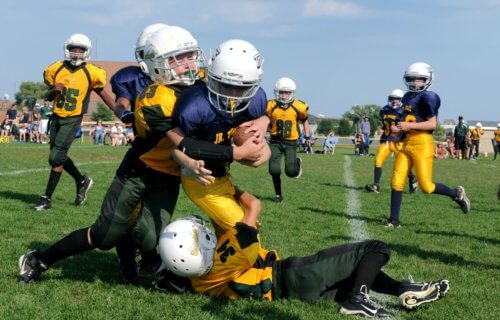WINSTON-SALEM, N.C. — With kids finally starting to get back outside to play and join team sports again, a new study may give parents new worries about signing their children up for things like football or soccer. Researchers from Wake Forest School of Medicine say head impacts aren’t just a concern in the NFL, they can be just as serious for youngsters too. Their findings reveal even non-serious head impacts can change a child’s brain for years to come.
Brain scans reveal microscopic abnormalities among youth football players, with the cumulative effect potentially leading to harm after just one season. Previous studies have led to scientists calling for youth soccer programs to ban heading, or hitting the ball with your skull. For football programs, these findings have led to stricter enforcement of concussions protocols.
“Our findings further support ongoing efforts to reduce the number of head impacts in football practices,” says lead author Dr. Jillian Urban in a university release.
“Although we need more studies to fully understand what the measured changes mean, from a public health perspective, it is motivation to further reduce head impact drills used during practice in youth football.”
Kids are taking hundreds of head impacts each year
Study authors based their recommendations on 3D images of the brain’s white matter, which controls learning and coordination. The team identified “abnormal voxels” in brain scans of several young football players. These changes were absent in their peers playing non-contact sports like swimming and tennis.
A voxel represents a tiny cube of brain tissue, similar to the 2D pixel of computer screens or televisions. Each can represent a million brain cells.
The 47 football players, all under 19 years-old, played the sport for a variety of teams for two or more consecutive years between 2012 and 2017. All wore football helmets fitted with a special sensor that records head impacts during both practice and actual games. In just one season, youth football players sustained between 26 and 1,003 head impacts. High school players took between 129 and 1,258 hits to the helmet.
Dr. Urban says, fortunately, most of these impacts don’t result in a concussion. In fact, most non-concussive impacts do not produce any acute signs or symptoms of a concussion — a blow which shakes the brain inside the skull. However, a closer analysis of 19 of these players identified changes to their brains after taking minor hits to the head.
Football players have dramatically different brain scans than other athletes
Each athlete underwent a sophisticated scanning technique called DTI (diffusion tensor imaging) before and after the football season. This scan is a type of MRI that measures the motion of microscopic water molecules in nerve fibers. Using four medical measurements, the researchers discovered each athlete’s white matter had changed, suggesting a possible brain injury.
Sixteen youths in non-contact sports underwent the same DTI tests twice over four months, serving as a control group. Dr. Urban’s team found that the voxels increased or decreased throughout the football season significantly. These results dramatically differed from the average scores in the control group. The study also reveals an individual’s number of head impacts during practice also have a link to their DTI readings.
Study authors say the amount of head impact exposure an athletes experiences, particularly in training, connects with the amount of change in their neuro-imaging results. Dr. Urban and her colleagues are now backing efforts to reduce the frequency of head contact in youth sports. They believe it will protect participants from brain abnormalities that can develop in as little as one season.
“We observed variability in the amount and direction of imaging changes in the brain related to the amount of exposure that the players experienced on the field. If we can take efforts to reduce that exposure on-field, we can potentially mitigate changes in brain imaging,” the assistant professor of biomedical engineering concludes.
“In an upcoming study, we plan to engage stakeholders in the youth football community to develop and test practical solutions informed by the data we collect on the field to reduce head impacts in practice.”
The findings appear in the Journal of Neurosurgery: Pediatrics.
SWNS writer Mark Waghorn contributed to this report.
